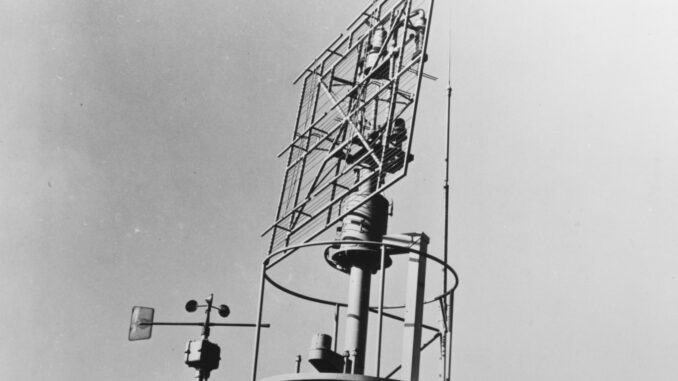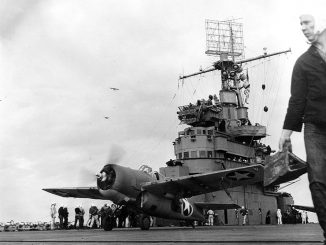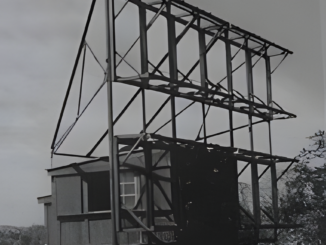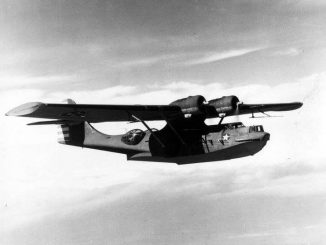
The CXAM, the US Navy’s first truly successful radar set, was too large to be fitted to smaller combatants like destroyers. It could only be fitted on ships the size of cruisers and larger, most commonly on aircraft carriers. The usefulness of radar was not limited to these large ships, so the Naval Research Laboratory soon received an order to design a version of the CXAM that was smaller and had a higher power output, to be the first long-range air-warning set for destroyers. The new prototype was designated XAR.
A new transmitter tube was designed for the NRL by the Eitel-McCullough Company which provided a 25-times increase in power over the CXAM, and the receiver was also much more sensitive. This allowed the antenna to be shrunk from the huge “bedspread” array of the CXAM to a more manageable 8.5ft x 7.5ft array, suitable for mounting at the top of a destroyer’s foremast. The old four-stack destroyer USS Semmes had been converted into an auxiliary ship specifically for the purposes of testing sonar and later radar systems. The XAR was fitted to her in July 1941, along with an experimental version of the SG surface-search radar. Experiments found that the XAR could detect airborne targets out to 60 miles.
Production contracts were let to RCA as the SA, and General Electric as the SC. SA sets were reserved primarily for destroyer escorts, whilst the SC was produced in large numbers for both destroyers and cruisers initially – but later sets were also issued for larger ships as backups for their larger primary sets like the SK. SA had a wavelength of 160cm, and SC 150cm, but otherwise they were broadly comparable.
Initial versions of the SC had an A-scope display, which showed the return signal against target range but not the top-down two-dimensional view that a PPI display provides. The A-scope was difficult for inexperienced operators to work with and may have contributed to early setbacks for the US surface fleet. The SC also had an issue with beams escaping out of the back of the antenna, which could confuse operators as returns appeared to be in front. These problems were especially acute when ships were in the presence of land, which provided confusing returns. Furthermore the SC, designed primarily for air warning, had a limited detection capabilities for surface contacts and the detection range for ships was only 10,000 yards, or less than 6 miles. Metre-wave sets like the SC had trouble with “clutter” caused by signal returns from wave action on the surface of the sea which could obscure targets, a problem that could only be solved by centimetric radar (meaning sets with a wavelength of 10cm or less) like the SG.
The nadir for the SC radar occurred during the Battle of Savo Island on 9 August, 1942, when a Japanese surface force without radar managed to surprise a superior Allied force plentifully equipped with sets, including several SC. The Japanese, under Admiral Mikawa, managed to slip past two SC-equipped destroyers, the Blue and Ralph Talbot, both of which detected enemy floatplanes but not the surface force. An Allied cruiser force likewise failed to detect the intruders, as several of the SC sets were not operating continuously and the ones that were on the air also failed to spot Mikawa until it was too late. In the ensuing attack, four Allied cruisers were taken by surprise and sunk by a combination of torpedoes and gunfire.
Changes were made to the basic design of the SC to improve its capabilities throughout the war. The SC-1 had a much higher power output with a consequent increase in detection range for aircraft to about 75 miles. SC-2 was a much-improved design and the definitive form of the SC, with a new, distinctive 15ft by 4ft antenna and the addition of a PPI display, which greatly enhanced the usefulness of the equipment for operators, as well as the ability to fit IFF components for the identification of airborne contacts.
Rapid increases in production of the SG meant that warships could be fitted with both the SC and the SG, with the SC reverting to its primary role of providing air warning capabilities. Production of the SC also increased rapidly, with the set often fitted to larger ships as a backup for their primary air warning sets. Late in the war, it was not uncommon for the large Essex-class aircraft carriers to sport half a dozen radars, with the SC located towards the rear of the island to cover blind spots as well as a reserve capability in case the larger SK sets failed. The SK itself was partly derived from the SC, utilising many of the same electronic components but pairing them with an antenna similar to that of the CXAM.
The SC remained the primary air warning radar for destroyers though, and its capabilities were showcased as the war progressed into the Western Pacific and the kamikaze menace began to make its presence felt. In response, US Navy leaders began to use destroyers as outlying pickets, operating 50-60 miles away from the main carrier fleet with fighters in attendance. These “Tomcat” ships were tasked with providing early warning of incoming raids and “de-lousing” returning returning strike missions to make sure that no Japanese interlopers were able to shadow them back to their carriers.
The hazardous nature of this duty was fully evident during the Okinawa campaign when many destroyers were posted to radar picket locations to provide early warning and fighter direction services in protection of the beachhead. These stations were particularly hazardous for the assigned destroyers – 10 were sunk and 32 damaged whilst operating in this role, despite the direct support of Navy and Marine fighters. Still, the picket teams did excellent work in thinning out the number of kamikazes that were able to get closer to the invasion fleet of Okinawa, proving the overall concept albeit at a devastating cost.
Variants:
- SC: Original version. 100kW output, 8.5ft x 7.5ft antenna array, A-scope.
- SC-1: Twice as much power (200kW), approx. double range. SCs were converted to this standard.
- SC-2: 15ft by 4ft antenna. IFF added (BG or BL). PPI.
- SC-3: Minor changes
- SC-4: Minor changes
- SC-5: Stopgap production to cover delays in SR production.




Leave a Reply